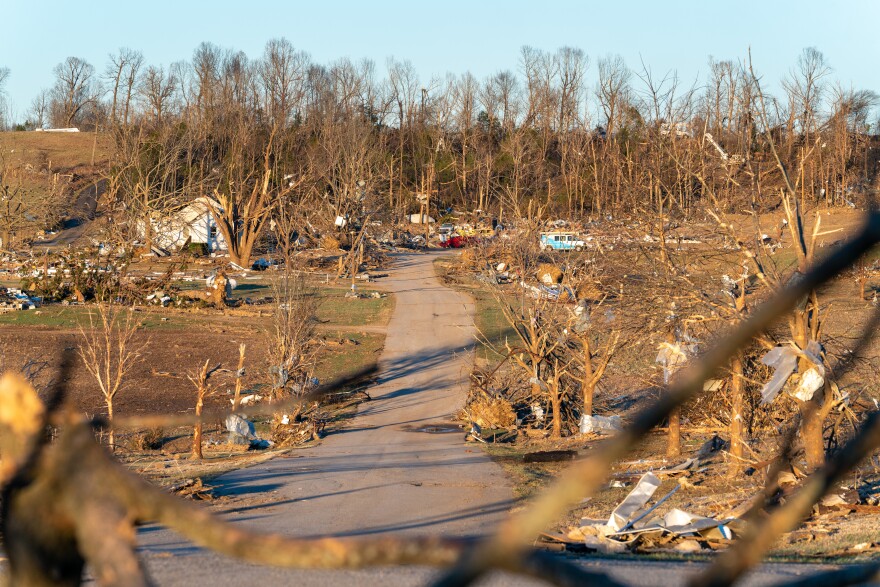The western Kentucky counties where last week's storm struck were the site of more than a quarter of all of Kentucky’s tornadoes between 2008 and 2018.
According to data from the National Centers for Environmental Information, the collective impact of all of those storms — three deaths, 61 injuries and nearly $50 million in property damage — already pales in comparison to the damage done by last week’s tornado system.
Gov. Andy Beshear said this week there is not yet an official estimate, but the total cost of the damage will be “enormous.” Though it’s too soon to know the financial toll, state and local disaster preparedness plans reviewed by KyCIR show the potential cost for storm-related losses by calculating the value of homes, industries and other facilities in each county.
In all, there was more than $18.2 billion at risk of being lost to tornadoes or severe wind in the 12 hardest-hit counties, according to a review of state and local plans preparing for destructive wind. That number is certainly an overestimate of what was destroyed last weekend; it assumes the loss of all assets across each of those counties.
But the damage across western Kentucky from last weekend’s storms is historic, and the recovery and restoration process will be lengthy, according to Kentucky Emergency Management director Michael E. Dossett.
Federal and state officials are continuing to survey damage, Dossett said. But by Tuesday, state emergency crews had mapped at least 5,000 points of destruction in the 12 counties, Dossett said.
There have already been 18 separate billion-dollar disaster events in the United States.
The storms in Kentucky will likely surpass that.
Forecasters with AccuWeather estimate the total damages across the four states hit by the tornadoes will exceed $18 billion — much of the costs will be in Kentucky.
High risks
State officials have long considered tornadoes to pose a significant risk across western Kentucky. The threat is especially high in the counties in the path of last week’s deadly tornado front: Fulton, Hickman, Graves, Marshall, Lyon, Caldwell, Christian, Hopkins, Muhlenberg, Ohio, Breckinridge and Warren.
Hazard mitigation plans are completed every six years by officials in the state’s 15 area development districts, quasi-state entities that help connect local, state and federal officials. The separate plans are then compiled into the statewide hazard mitigation plan, maintained by the state’s Division of Emergency Management.
Local officials conduct a “collaborative analysis” of previous and potential disasters when they update hazard mitigation plans, said Tony Wilder, the executive director of the Kentucky Council of Area Development Districts.
“There are always lessons learned,” he said.
https://wfpl.org/heres-how-to-apply-for-fema-disaster-relief-and-what-to-avoid/
Last Friday’s storm carved through four states and stretched more than 220 miles. As of Thursday, 76 people in Kentucky had died in connection with the storm, and 16 people were still missing — 15 from Hopkins County alone.
The county plans show the hardest-hit counties were home to:
- more than 428,000 people
- 158,000 homes
- hundreds of local and state owned critical facilities — like schools, government buildings, hospitals, sewage and power plants.
During a press conference Tuesday, Dossett said emergency crews and volunteers are still in the “blue tarp” phase of response — trying to protect damaged homes from winter rains and salvage the ones they can.
‘Random and unpredictable’
Graves County was among the most damaged by tornadoes last week. The county seat, Mayfield, suffered severe destruction.
https://wfpl.org/disbelief-among-the-rubble-mayfield-community-stunned-by-tornados-destruction/
There are more than 16,000 homes in Graves County, and $1.1 billion worth of critical infrastructure, according to the hazard mitigation plans. Dossett on Tuesday didn’t address the overall scope of the damage, but he said the power grid in Mayfield “doesn’t exist.”
When a tornado strikes, nothing is considered safe, according to the county’s mitigation plan.
“Any area in the county is as vulnerable as another and the events are completely random and unpredictable,” the plan states.
Despite the risk and the regularity of tornadoes in the county — 17 were recorded between 2008 and 2018 — the mitigation plan offers little detail about specific measures to prevent destruction or death during a violent storm.
But it does offer a grim warning.
“Graves County can and has suffered frequent tornado events,” the plan states. “Any one of those events could be especially ruinous to the county.”
‘More frequent’
The National Weather Service Paducah field office covers the 22-county region in far western Kentucky. It reported 232 observed tornadoes between June 2005 and Sept. 2018 — more than the state’s other two field offices in Louisville and eastern Kentucky, combined.
Still, the state’s costliest tornado in recent years struck in eastern Kentucky in 2012. That storm tore through six counties, ultimately causing more than $148 million in damages.
That storm traveled more than 20 miles and caused six deaths, according to the National Centers for Environmental Information.
Since then, there have been more than 181 tornadoes across the state — and more than 60% were in western Kentucky.
Just six of the storms occurred during the month of December, according to the environmental data.
Winter storms will become more frequent as the climate warms, and officials say the so-called “tornado alley” — traditionally in the central plains region of the county — is moving to the midwest and south.
Kentucky sits squarely in the middle of these shifting storm patterns.
This story has been updated.
Contact Jacob Ryan at jryan@kycir.org.






